Brother PE 400D User Manual

OPERATION MANUAL
®
“IMPORTANT SAFETY INSTRUCTIONS”
When using a sewing machine, basic safety precautions should always be taken, including the following:
“Read all instructions before using.” DANGER – To reduce the risk of electric shock.
1.The sewing machine should never be left unattended while plugged in. Always unplug the sewing machine from the electrical outlet immediately after using and before cleaning.
2.Always unplug before changing the light bulb. Replace bulb with same type rated 8V 2.4 watts.
WARNING – To reduce the risk of burns, fire, electric shock, or injury to persons.
1.Do not allow this sewing machine to be used as a toy. Close attention is necessary when the sewing machine is used by or near children.
2.Use this sewing machine only for its intended use as described in this manual. Use only accessories recommended by the manufacturer as contained in this manual.
3.Never operate this sewing machine if it has a damaged cord or plug, if it is not working properly, if it has been dropped or damaged, or dropped into water. Return the sewing machine to the nearest authorized dealer or service center for examination, repair, electrical or mechanical adjustment.
4.Never operate the sewing machine with any air openings blocked. Keep ventilation openings of the sewing machine and foot control free from the accumulation of lint, dust, and loose cloth.
5.Never drop or insert any object into any opening.
6.Do not use outdoors.
7.Do not operate where aerosol (spray) products are being used or where oxygen is being administered.
8.To disconnect, turn the main switch to the symbol “O” position which represents off, then remove plug from outlet.
9.Do not unplug by pulling on cord. To unplug, grasp the plug, not the cord.
10.Keep fingers away from all moving parts. Special care is required around the sewing machine needle.
11.Always use the proper needle plate. The wrong plate can cause the needle to break.
12.Do not use bent needles.
13.Do not pull or push fabric while stitching. It may deflect the needle causing it to break.
14.Switch the sewing machine to the symbol “O” position when making any adjustments in the needle area, such as threading needle, changing needle, threading bobbin, or changing presser foot, and the like.
15.Always unplug the sewing machine from the electrical outlet when removing covers, lubricating, or when making any other user servicing adjustments mentioned in the instruction manual.
16.This sewing machine is not intended for use by young children or infirm persons without supervision.
17.Young children should be supervised to ensure that they do not play with this sewing machine.
“SAVE THESE INSTRUCTIONS”
“This sewing machine is intended for household use.”
FOR USERS IN THE UK, EIRE, MALTA
AND CYPRUS ONLY.
If your sewing machine is fitted with a three-pin non-rewireable BS plug then please read the following.
IMPORTANT
If the available socket outlet is not suitable for the plug supplied with this equipment, it should be cut off and an appropriate three-pin plug fitted. With alternative plugs an approved fuse must be fitted in the plug.
NOTE
The plug served from the main lead must be destroyed as a plug with bared flexible cords is hazardous if engaged in a live socket outlet. In the event of replacing the plug fuse, use a fuse approved by ASTA to BS 1362, i.e. carrying the  mark, rating as marked on plug.
mark, rating as marked on plug.
Always replace the fuse cover, never use plugs with the fuse cover omitted.
WARNING
DO NOT CONNECT EITHER WIRE TO THE EARTH TERMINAL WHICH IS MARKED WITH THE LETTER ‘E’, BY THE EARTH SYMBOL  OR COLOURED GREEN OR YELLOW.
OR COLOURED GREEN OR YELLOW.
The wires in this main lead are coloured in accordance with the following code:
Blue Neutral
Brown Live
As the colours of the wiring in the main lead of this appliance may not correspond with the coloured markings identifying the terminals in your plug, proceed as follows.
The wire which is coloured blue must be connected to the terminal which is marked with the letter ‘N’ or coloured black or blue.
The wire which is coloured brown must be connected to the terminal which is marked with the letter ‘L’ or coloured red or brown.
CONGRATULATIONS ON CHOOSING
A BROTHER COMPUTER SEWING MACHINE
Your machine is the most advanced computerized home use sewing machine available. To fully enjoy all the features incorporated into it, we suggest that you study this booklet.
PLEASE READ BEFORE USING YOUR SEWING MACHINE
For safe operation
1.Be sure to keep your eye on the needle while sewing. Do not touch the balance wheel, thread take-up, needle, or other moving parts.
2.Remember to turn off the power switch and unplug the cord when:
●Operation is completed
●Replacing or removing the needle or any other parts
●A power failure occurs during use
●Maintaining the machine
●Leaving the machine unattended
3.Do not store anything on the foot controller.
4.Plug the machine directly into the wall. Do not use extension cords.
For a longer service life
1.When storing your sewing machine, avoid direct sunlight and high humidity locations. Do not store the sewing machine beside a space heater, iron, or other hot objects.
2.Use only neutral soaps or detergents to clean the case. Benzene, thinner, and scouring powders can damage the case and machine, and should never be used.
3.Do not drop or hit the machine.
4.Always consult the operation manual when replacing or installing any accessories, the presser feet, needle, or other parts to assure correct installation.
For repair or adjustment
In the event that a malfunction occurs or adjustment is required, first follow the troubleshooting table in the back of the operation manual to inspect and adjust the machine yourself. If the problem persists, please consult your nearest authorized Brother service center.
1
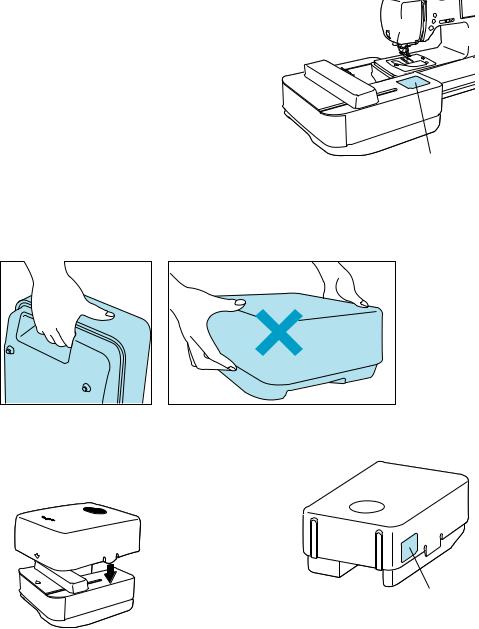
WARNING LABELS
There should be several warning labels on your sewing machine.
Please heed warning labels when operating the sewing machine.
If you don't understand the warnings, please contact the place of purchase.
CAUTION
Always remove the embroidery unit before moving the sewing machine. Otherwise the embroidery unit could fall and cause bodily injury or damage to the unit.
Warning label
CAUTION
Always carry the embroidery unit by the handle as illustrated in Fig. 1. Do not carry it by the sides as shown in Fig. 2 or the unit may fall out from under the cover and cause bodily injury or damage to the unit.
Fig. 1 |
Fig. 2 |
•When putting the embroidery unit cover onto the unit, place it so that the arrow is on the side of the carrying handle.
Warning label
2
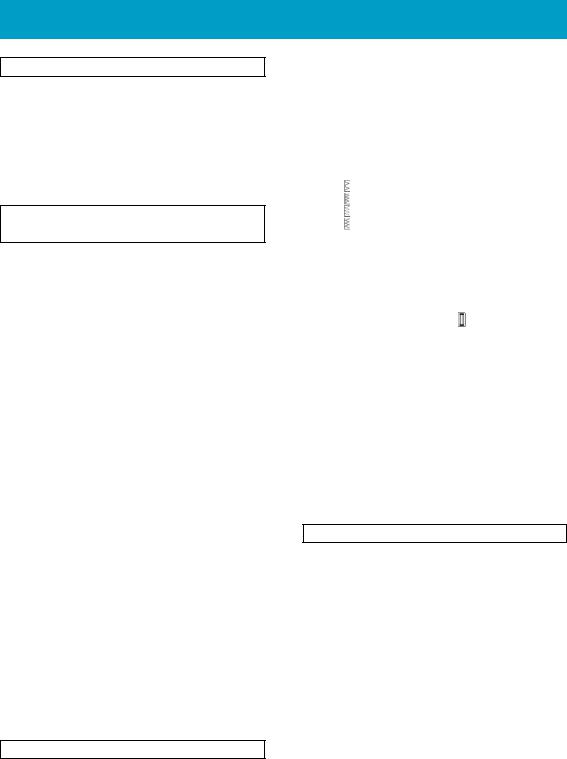
CONTENTS |
|
SETTING UP |
|
................................................... |
5 |
PRINCIPAL PARTS ............................................. |
5 |
OTHER INCLUDED ACCESSORIES .................. |
7 |
OPTIONS ............................................................. |
8 |
SELECTION KEYS .............................................. |
9 |
Screen messages guide you through each |
|
operation ........................................................ |
9 |
OPERATION BUTTONS .................................... |
10 |
Using the operation buttons ......................... |
10 |
BASIC SEWING MACHINE |
|
OPERATION |
|
................................................. |
11 |
FLAT BED EXTENSION TABLE ........................ |
11 |
Free arm ...................................................... |
11 |
POWER SUPPLY ............................................... |
12 |
USING THE SCREEN KEYS ............................. |
13 |
ABOUT THE SCREEN ....................................... |
13 |
ADJUSTING THE BRIGHTNESS OF THE |
|
SCREEN ............................................................ |
13 |
HOW TO CHANGE LANGUAGE ....................... |
14 |
How to clear the language selection ............ |
15 |
BOBBIN WINDING / BOBBIN THREAD |
|
SETTING ............................................................ |
16 |
Setting the bobbin ........................................ |
19 |
UPPER THREADING ......................................... |
20 |
STARTING AND STOPPING SEWING ............. |
23 |
“START/STOP” button ................................. |
23 |
Foot controller .............................................. |
23 |
STITCH SELECTION (UTILITY STITCHES) ..... |
24 |
Stitches ........................................................ |
24 |
TRIAL SEWING .................................................. |
25 |
STITCH WIDTH AND STITCH LENGTH ........... |
27 |
Adjusting the stitch width ............................. |
27 |
Adjusting the stitch length ............................ |
27 |
Quick adjustment reference chart for stitch |
|
width and stitch length ................................. |
28 |
THREAD TENSION ............................................ |
30 |
Correct tension ............................................. |
30 |
Tightening the upper thread tension ............ |
30 |
Loosening the upper thread tension ............ |
30 |
PRESSER FOOT ............................................... |
31 |
Changing the presser foot ............................ |
31 |
Changing the Embroidery foot and the |
|
zipper foot .................................................... |
32 |
FEED DOGS ...................................................... |
33 |
NEEDLE ............................................................. |
34 |
Checking the needle .................................... |
34 |
Installing the needle securely ....................... |
34 |
FABRIC/THREAD/NEEDLE COMBINATION |
|
CHART ............................................................... |
35 |
UTILITY STITCHES |
|
................................................. |
36 |
STRAIGHT STITCHES ...................................... |
36 |
Changing needle position ............................ |
37 |
Sewing corners ............................................ |
37 |
Sewing curves .............................................. |
38 |
Sewing thick seams ..................................... |
38 |
Sewing thick fabric ....................................... |
38 |
Sewing thin fabric ......................................... |
39 |
Using the free arm ....................................... |
39 |
STRETCH STITCH AND TRIPLE STITCH ........ |
40 |
Stretch stitch ................................................ |
40 |
Triple stitch ................................................... |
40 |
ZIGZAG STITCHES ........................................... |
41 |
Overcasting (using a zigzag stitch) .............. |
41 |
Applique (using a zigzag stitch) ................... |
41 |
Patchwork (for crazy quilt) ........................... |
42 |
Sewing a curve with a zigzag stitch ............. |
42 |
DOTTED ZIGZAG .............................................. |
43 |
Attaching elastic bands ................................ |
43 |
Overcasting .................................................. |
43 |
OVERCASTING ................................................. |
44 |
Overcasting ............................................... |
44 |
Overcasting ............................................... |
44 |
Overcasting ............................................... |
45 |
Overcasting ............................................... |
45 |
BLIND HEM STITCHES ..................................... |
46 |
If the needle does not catch the fold of |
|
hem enough. ................................................ |
47 |
If the needle catches the fold of hem |
|
too much. ..................................................... |
47 |
BUTTONHOLE STITCHES ................................ |
48 |
Order of one cycle ........................................ |
49 |
Sewing stretch fabrics ( ) .......................... |
50 |
Buttons that do not fit into the guide plate |
|
(Odd-shaped buttons) .................................. |
50 |
BAR TACKING ................................................... |
51 |
Thick fabrics ................................................. |
52 |
APPLIQUES ....................................................... |
53 |
Sewing the applique around corners ........... |
53 |
SCALLOP ........................................................... |
54 |
PATCHWORK STITCH ...................................... |
55 |
ZIPPER INSERTION |
|
(CENTERED AND SIDE APPLICATION) .......... |
56 |
Centered application .................................... |
56 |
Side application ............................................ |
57 |
SMOCKING ........................................................ |
59 |
BUTTON SEWING ............................................. |
60 |
Attaching buttons with four holes ................. |
61 |
EMBROIDERING |
|
................................................. |
62 |
BEFORE YOU BEGIN ........................................ |
62 |
1. Embroidery unit and memory cards |
|
(optional). ..................................................... |
62 |
2. Attaching the embroidery foot “Q” ............ |
62 |
3. Attaching the embroidery unit .................. |
63 |
REMOVING EMBROIDERY UNIT ..................... |
64 |
CHOOSING EMBROIDERY PATTERNS |
|
(PART I) ............................................................. |
65 |
One-point patterns ....................................... |
66 |
Borders ........................................................ |
68 |
Lettering ....................................................... |
69 |
Numerals and punctuation ........................... |
70 |
Lower and upper case letters ....................... |
70 |
Selecting patterns from a memory card ....... |
71 |
CHOOSING EMBROIDERY PATTERNS |
|
(PART II) ............................................................ |
72 |
If you accidentally choose the wrong design .... |
72 |
If you choose the wrong character ............... |
72 |
To change size ............................................. |
72 |
To make words ............................................ |
73 |
EMBROIDERING ............................................... |
74 |
Embroidering attractive finishes ................... |
74 |
Setting the fabric into the embroidery frame .... |
75 |
Fitting the embroidery frame to the |
|
embroidery unit ............................................ |
77 |
Removing the embroidery frame .................. |
77 |
Embroidering ................................................ |
78 |
THREAD TENSION ............................................ |
80 |
3
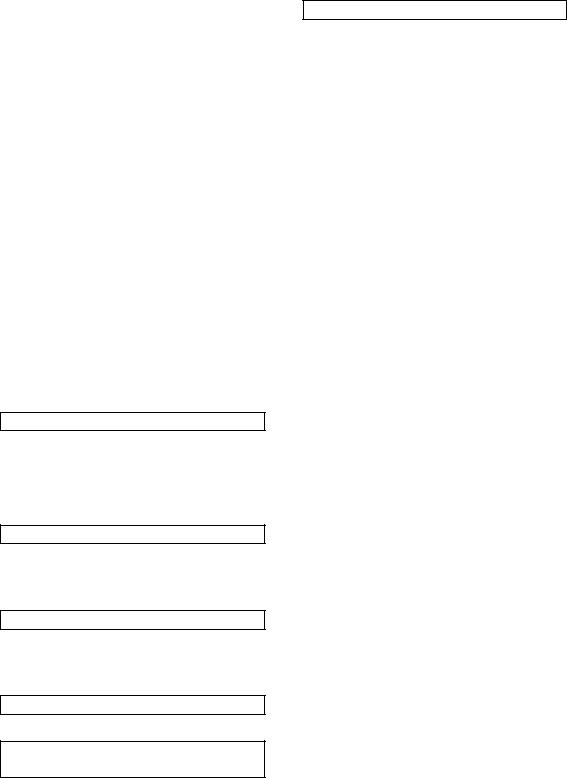
CHECKING THREAD COLORS AND TIME |
|
REQUIRED ........................................................ |
81 |
Checking thread colors ................................ |
81 |
Checking time required to complete a |
|
pattern .......................................................... |
82 |
CHOOSING EMBROIDERY PLACEMENT ........ |
83 |
Moving the embroidery location ................... |
84 |
Checking the embroidering area .................. |
84 |
Embroidering from a specific starting point .. |
85 |
ROTATING AND MIRRORING PATTERNS ...... |
86 |
Rotating patterns .......................................... |
86 |
Mirroring patterns ......................................... |
86 |
CHANGING SIZE AND STITCH DENSITY OF |
|
CHARACTERS AND BORDERS ....................... |
87 |
To change size ............................................. |
87 |
To change stitch density |
|
(limited to certain alphabets and borders) .... |
88 |
Multi-colored lettering ................................... |
88 |
IF THE THREAD BREAKS DURING |
|
EMBROIDERY ................................................... |
89 |
If the upper thread breaks ............................ |
89 |
When starting over from the beginning ........ |
90 |
Continuing after the power shuts off ............ |
90 |
EMBROIDERY APPLICATIONS ........................ |
91 |
Combining characters to form words ........... |
91 |
Outline Embroidery ...................................... |
92 |
Embroidering appliques |
|
(using a frame pattern) ................................. |
93 |
Embroidering onto small pieces of fabric or |
|
onto corners ................................................. |
94 |
MEMORY ........................................................... |
95 |
Saving groups of characters ........................ |
95 |
Restoring saved designs .............................. |
96 |
MAINTENANCE |
|
................................................. |
97 |
CLEANING ......................................................... |
97 |
Cleaning the screen ..................................... |
97 |
Cleaning the sewing machine surface ......... |
97 |
Cleaning the shuttle ..................................... |
97 |
CHANGING THE LIGHT BULB .......................... |
99 |
TROUBLESHOOTING |
|
............................................... 100 |
|
BEFORE TAKING YOUR MACHINE |
|
IN FOR SERVICE ............................................ |
100 |
Basic sewing machine maintenance .......... |
100 |
ERROR MESSAGES |
|
............................................... 103 |
|
Warning messages .................................... |
103 |
Instruction messages ................................. |
105 |
Alarms ........................................................ |
105 |
SEWING CHART |
|
......................................................................... |
106 |
PATTERNS (PROGRAMMED IN |
|
MACHINE) |
|
............................................... 107 |
|
Utility stitches ............................................. |
107 |
Character embroidering chart .................... |
107 |
Frame pattern embroidering chart ............. |
107 |
PATTERNS (MEMORY CARD) |
|
............................................... |
108 |
ONE POINT MARK EMBROIDERY |
|
PATTERN ......................................................... |
108 |
4

SETTING UP
PRINCIPAL PARTS
1
2
3
4
5
D
6
7
8
9
10
11
B
1– Handle
2– Spool cap
3– Thread guide for bobbin winding
4– Upper tension control dial
5– Speed range control lever
6– Thread cutter
7– Buttonhole lever
8– Needle threader
9– Presser foot
10– Feed dog
11– Bobbin cover
12– Bobbin winder
13– Balance wheel
14– Feed dog adjustment lever
15– Controller jack
16– Presser foot lever
1
2
A
3
4
5
12
13
C
A 16
14
15
A– Main power switch and connectors B– Accessory compartment
C– L.C.D. (Liquid Crystal Display)
D– Operation buttons (Refer to page 10)
Embroidery Unit Parts
1 |
Carriage |
2 |
Hoop holder |
3 |
Connector |
A. |
Side view |
4 |
Release button |
5 |
Embroidery Unit Handle |
5
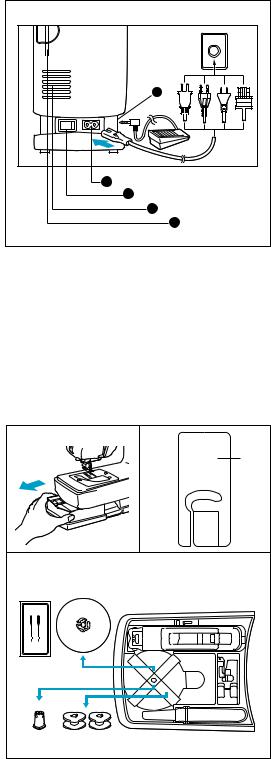
5 |
1 |
2 |
3 |
4 |
I |
|
II |
|
|
|
J |
1 |
|
|
|
|
III |
|
|
|
5 |
|
|
|
|
6 |
|
|
|
|
1 |
|
7 |
4 |
|
2 |
|
|
||
|
|
3 |
|
A. MAIN POWER SWITCH AND CONNECTORS
1 Power socket
Use to connect machine to power supply.
2Main power switch
Use to turn on/off the main power.
3 Air vents
4Card slot
Slot for memory card insertion.
5Foot controller jack
Use to connect the foot controller.
CAUTION
–When leaving the sewing machine unattended, the main switch of the machine must be switched off or the plug must be removed from the socket-outlet.
–When servicing the sewing machine, or when removing covers or changing bulbs, the machine or the electrical set must be unplugged.
–For U.S.A. only
This appliance has a polarized plug (one blade wider than the other). To reduce the risk of electric shock, this plug is intended to fit in a polarized outlet only one way.
If the plug does not fit fully in the outlet, reverse the plug. If it still does not fit, contact a qualified electrician to install the proper outlet. Do not modify the plug in any way.
B. FLATBED ATTACHMENT WITH ACCESSORY COMPARTMENT
ISlide accessory case to the left and out of the machine.
II Each presser foot has a letter. 1 Presser foot letter
IIIACCESSORY LIST
The location of each accessory is shown in figure III.
No. |
Part Name |
Part Code |
1 |
Buttonhole foot “A” |
X57789-101 |
|
|
|
2 |
Overcasting foot “G” |
X51162-001 |
|
|
|
3 |
Seam ripper |
X54243-001 |
|
|
|
4 |
Bobbin |
X80309-001 |
|
|
|
5 |
Needle set |
XA6627-001 |
|
|
|
6 |
Spool cap (Large) |
130012-053 |
|
|
|
7 |
Spool cap (Small) |
XA5752-001 |
|
|
|
*Always use BROTHER accessories with this machine.
6
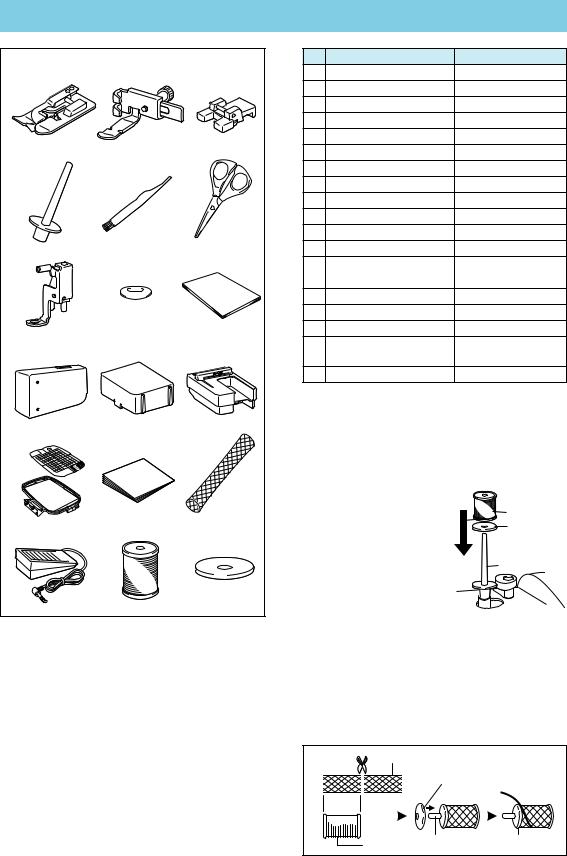
OTHER INCLUDED ACCESSORIES |
|
|
|
|||
1 |
2 |
3 |
No. |
Part Name |
Part Code |
|
1 |
Blind stitch foot “R” |
X56409-001 |
||||
|
|
|
||||
|
|
|
2 |
Zipper foot “I” |
103561-002 |
|
|
R |
|
3 |
Button sew-on foot |
X59375-051 |
|
|
|
|
4 Extra spool pin * |
XA3336-051 |
||
|
|
|
5 |
Cleaning brush |
X59476-051 |
|
4 |
5 |
6 |
6 |
Scissors |
184783-001 |
|
7 |
Embroidery foot “Q” |
XA5357-001 |
||||
|
|
|
8 |
Key |
XA2005-051 |
|
|
|
|
9 |
Owner's Manual |
— |
|
|
|
|
10 |
Hard case/Extension table |
— |
|
|
|
|
11 |
Embroidery Unit Cover |
— |
|
7 |
8 |
9 |
12 |
Embroidery unit |
— |
|
13 |
Embroidery frame set |
SA432 (USA) |
||||
|
|
|
|
(Regular) |
XA6628-002 (Others) |
|
|
|
|
14 Backing material (Stabilizer material) |
— |
||
|
|
|
15 |
Net ** |
XA5523-050 |
|
|
|
|
16 |
Foot controller |
XC1154-051 |
|
10 |
11 |
12 |
17 |
Embroidery bobbin thread |
SABTS (USA) |
|
|
|
X81164-001 (Others) |
||||
|
|
|
|
|
||
|
|
|
18 |
Spool felt* |
X57045-051 |
|
|
|
|
* Extra spool pin and spool felt |
|||
|
|
|
Use when embroidering with metallic thread. |
|||
13 |
14 |
15 |
1. Insert the extra spool pin into the end of the |
|||
bobbin winder shaft. |
|
|||||
|
|
|
2. Install the spool felt and the thread spool in that |
|||
|
|
|
order, and then thread the upper thread. |
|||
|
|
|
1 Insert the extra spool |
|
||
|
|
|
pin into the end of the |
3 |
||
|
|
|
bobbin winder shaft |
|||
16 |
17 |
18 |
2 |
|||
2 Spool felt |
||||||
|
||||||
3 Thread spool |
|
|||||
|
|
|
|
|||
|
|
|
* |
When setting the |
1 |
|
|
|
|
|
thread spool, set it |
||
|
|
|
|
|
||
|
|
|
|
so that the thread |
|
|
|
|
|
|
winds off from the |
|
|
|
|
|
|
front of the spool. |
|
|
|
|
|
* If using metallic thread, we recommend that |
|||
|
|
|
|
you use a 90/14 home sewing machine nee- |
||
Note |
|
|
|
dle. |
|
|
|
|
|
|
|
||
This method keeps the thread from twisting as it comes off the spool pin. |
|
|||||
** Net
If using special threads which wind quickly off the thread spool, attach a net to the spool before using. : Cut the net to match the size of the spool.
1 |
Net |
|
1 |
|
2 |
Thread spool |
|
4 |
|
3 |
Spool pin |
|
|
|
4 |
Spool cap |
|
|
|
If using metallic thread, we recommend that you |
|
|
|
|
use a 90/14 home sewing machine needle. |
2 |
3 |
4 |
|
|
|
|
|
|
Note (For U.S.A. only)
Foot controller : Model N5V
This foot controller can be used for sewing machine model PE-300S/PE-400D.
7
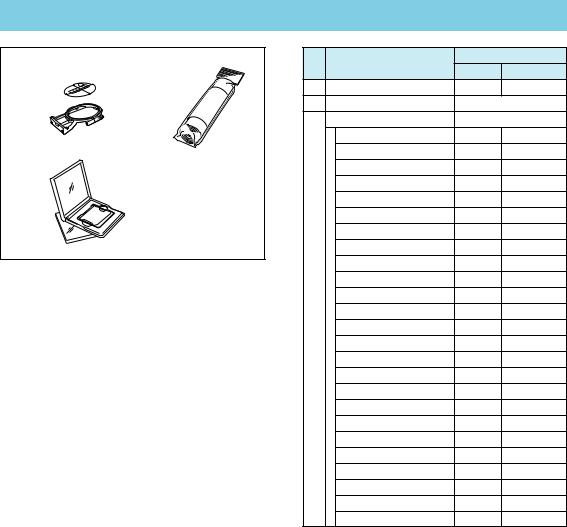
OPTIONS
|
|
No. |
Part Name |
Part Code |
||
1 |
2 |
U.S.A. |
Others |
|||
|
|
|||||
|
|
|
|
|||
|
|
1 Embroidery frame set (Small) |
SA431 |
XA6630-002 |
||
|
|
2 Backing material (Stabilizer material) |
X80914-001 |
|||
|
|
Memory card |
|
|
||
|
|
No.1 |
Alphabet |
SA298 |
X58317-001 |
|
3 |
|
No.2 |
Flower |
SA299 |
X58321-001 |
|
|
No.6 |
Moskowitz’s World |
SA303 |
X58497-001 |
||
|
|
|||||
|
|
No.7 |
Country Life |
SA304 |
X59322-001 |
|
|
|
No.8 |
Holiday |
SA305 |
X59357-001 |
|
|
|
No.9 |
Hobby Craft |
SA306 |
X59511-001 |
|
|
|
No.10 |
Monogram emblem |
SA307 |
X59567-001 |
|
|
|
No.12 |
Transportation |
SA312 |
XA0275-001 |
|
|
|
No.13 |
Sports Emblem |
SA313 |
XA0517-001 |
|
|
|
No.16 |
Dogs & Cats |
SA316 |
XA1406-001 |
|
|
|
No.20 |
Petite Designs |
SA320 |
XA2869-001 |
|
|
|
No.21 |
Needlework |
SA321 |
XA2873-001 |
|
|
|
3 |
|
|
|
|
|
|
No.25 |
Horse |
SA325 |
XA3791-001 |
|
|
|
No.27 |
Birds |
SA327 |
XA4289-001 |
|
|
|
No.28 |
Christmas |
SA328 |
XA4502-001 |
|
|
|
No.29 |
Lace |
SA329 |
XA4664-001 |
|
|
|
No.30 |
Wildlife Animals |
SA330 |
XA4771-001 |
|
|
|
No.32 |
Musical instrument |
SA332 |
XA5386-001 |
|
|
|
No.33 |
Trees |
SA333 |
XA5567-001 |
|
|
|
No.35 |
Cats & Dogs ll |
SA335 |
XA5629-001 |
|
|
|
No.36 |
Fruits & Vegetables |
SA336 |
XA5659-001 |
|
|
|
No.37 |
Applique Alphabet |
SA337 |
XA5753-001 |
|
|
|
No.38 |
Angel |
SA338 |
XA5781-001 |
|
|
|
No.39 |
Doll Face |
SA339 |
XA5978-001 |
|
|
|
No.40 |
Sports 3 |
SA340 |
XA6111-001 |
|
WARNING
Embroidery Cards purchased overseas or non Brother brand embroidery cards may not work with your machine.
8
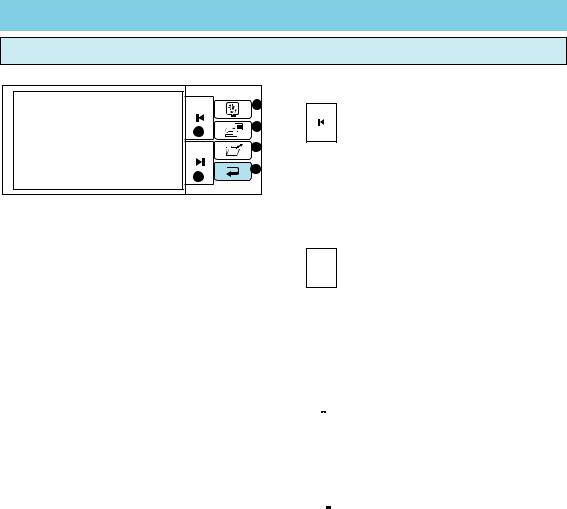
SELECTION KEYS
Screen messages guide you through each operation
|
|
SELECTION KEYS |
|
|
3 |
|
|
1 |
4 |
1 “ |
” KEY |
|
|
|
|
|
5 |
Press while in the pattern selection screens to go |
|
|
|
||
2 |
6 |
back one page. (also used in Save and Restore |
|
|
|||
|
|
screens) |
|
2“  ” KEY
” KEY
Press to advance one screen while in pattern selection screens. (also used during Save and Restore operations)
3“  ” KEY
” KEY
Pushing this key will take you to the screen that will let you select pattern to embroider.
4“  ” KEY
” KEY
Select this when you wish to edit a selected pattern (sewing position, size, stitch density, etc...).
5“  ” KEY
” KEY
Use this key to save or retrieve combined letters.
6“  ” KEY
” KEY
Press to go back one screen of operation screens.
9
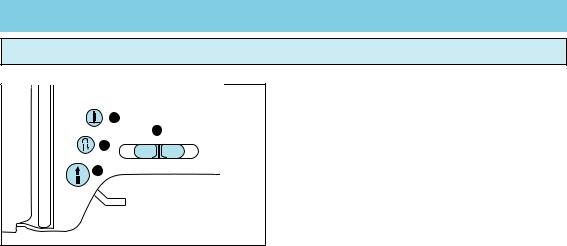
OPERATION BUTTONS
Using the operation buttons
|
OPERATION BUTTONS |
|
2 |
1 |
Speed range control lever |
1 |
|
Slide this lever to change the sewing speed. |
3 |
|
|
4 |
2 |
“NEEDLE POSITION” button |
|
|
Press this button to move the needle either up or |
|
|
down. |
3“REVERSE STITCH” button
Hold down this button to sew either backwards or in the same place at a slow speed. When sewing a reverse stitch, sewing is done in reverse.When sewing a reinforcement stitch, three stitches are sewn at the same position.
4“START/STOP” button
Press this button to start the machine, and then press it once more to stop the machine.
*Sewing continues at a slow speed while this button is pressed.
*The needle will stop to its highest position when the machine is stopped.
10

BASIC SEWING MACHINE OPERATION
FLAT BED EXTENSION TABLE
*Sewing machine cover converts to a flat bed extension table.
1.Slide the sewing machine cover to the left and off the machine.
2. With the cutout section of the cover up, lift the machine a little bit and slide the cover, under the sewing machine along the grooves.
Free arm
The accessory case can be removed to expose the free arm.
1. Slide accessory case to the left and out of the machine.
2.Convenient for sewing hard to get at tubular areas like pant legs.
11
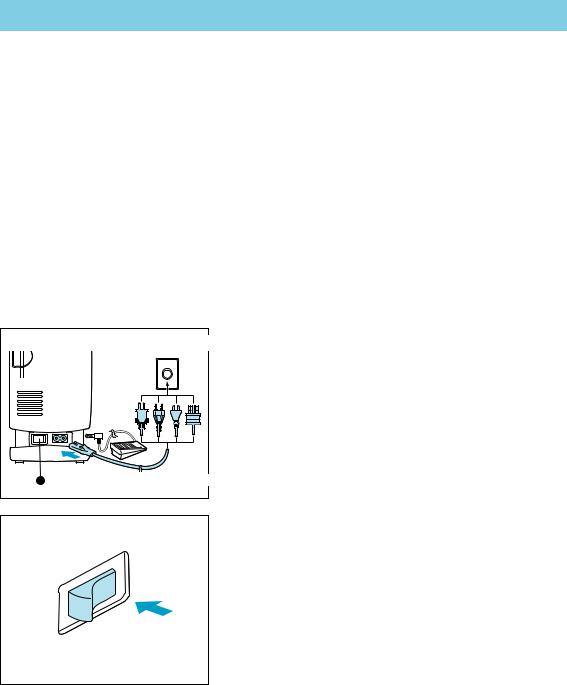
POWER SUPPLY
WARNING
–When leaving the sewing machine unattended or when it is not being used, turn off the main power switch of the machine or remove the plug from the wall outlet.
CAUTION
–Do not use this sewing machine with extension cords or multi-plug adaptors, otherwise a fire or an electric shock may occur.
–Do not remove the plug from the wall outlet with wet hands, otherwise an electric shock may occur.
–When unplugging the power cord, turn off the main power switch of the machine, then grasp the plug and pull to unplug the cord. Pulling on the cord may damage it or cause a fire or an electric shock.
–Do not allow the power cord to be cut, damaged, modified, forcefully bent, pulled, twisted or bundled. In addition, do not place heavy objects on the cord or subject it to heat, otherwise the cord may be damaged or a fire or an electric shock may occur.
If the power cord or plug are damaged, contact your nearest authorized Brother dealer or service center.
–If the sewing machine is not to be used for a long period of time, unplug the power cord, otherwise a fire may occur.
1 |
1. Insert the plug into a wall outlet.
1 Main power switch
2.Set the main power switch to “ I ”.
3.To turn off the sewing machine, set the main power switch to
“  ”.
”.
I
O
12
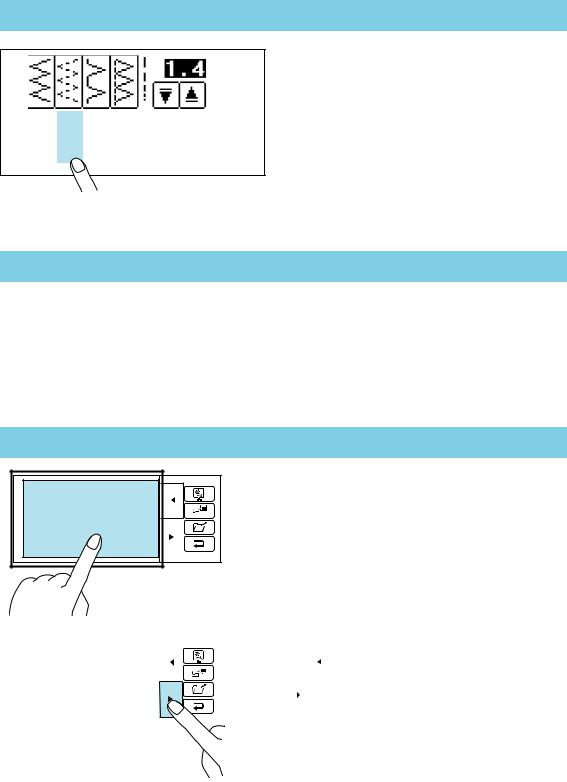
USING THE SCREEN KEYS
Touch a key on the screen with your finger to select the pattern which appears inside the key or to start the function or operation indicated inside the key.
CAUTION
Be sure to touch the key with your finger only. Never use a pointed instrument such as a sharp pencil or a screwdriver or a hard object to touch the key.
Furthermore, do not press down too hard on the screen, otherwise problems may result.
ABOUT THE SCREEN
NOTES
–All or parts of the screen may become darker or lighter at times because of changes in the ambient temperature around the screen. This is normal and is not the sign of a malfunction. Adjust the screen if it is difficult to read.
ADJUSTING THE BRIGHTNESS OF THE SCREEN
1. While touching the LCD, turn the power off and then back on again.
|
|
|
|
|
|
2. Press “ |
|
|
|
” key to soften the characters on the screen, |
||
|
|
|
|
|
|
|
|
|
||||
|
|
|
|
|
|
|
|
|
||||
|
|
|
|
|
|
|
|
|
||||
|
|
|
|
|
|
|
|
|
||||
|
|
|
|
|
|
|
|
|
||||
|
|
|
|
|
|
|
|
|
||||
|
|
|
|
|
|
|
|
|
||||
|
|
|
|
|
|
or “ |
|
|
|
|
|
|
|
|
|
|
|
|
|
|
|
|
” key to sharpen them. |
||
|
|
|
|
|
|
|
|
|
|
|||
|
|
|
|
|
|
|
|
|
|
|||
|
|
|
|
|
|
|
|
|
|
|
|
|
|
|
|
|
|
|
|
|
|
|
|
|
|
|
|
|
|
|
|
|
|
|
|
|
|
|
3. After you have finished adjusting, turn the power off and back on again once more.
13
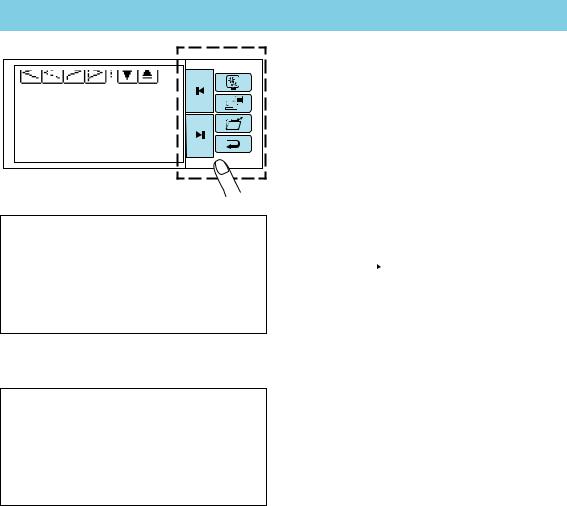
HOW TO CHANGE LANGUAGE
While touching a selection key, turn the power off and then back on again.
Example: To change the display language to
Spanish
1. |
Touch the “ |
|
|
” key. |
|
|
|||
|
|
|||
|
|
|
|
|
2. |
Touch “ESPAÑOL (SPANISH)”. |
|||
|
This will change the language setting to Spanish. |
|||
3. |
The display will then return to the screen which was |
|||
|
previously being displayed. |
|||
Note
*When the display language is set, error messages will also be displayed in the language selected.
*The display language can be selected from a list of 13 languages (English, German, French, Italian, Dutch, Spanish, Danish, Norwegian, Finnish, Swedish, Portuguese, Turkish and Chinese).
14

How to clear the language selection
While touching a selection key, turn the power off and then back on again.
Example: To change the display language from
Spanish back to English
1. Touch the “ENGLISH” key.
This will cancel the Spanish language setting. The display will then return to the screen which was previously being displayed.
CAUTION
–This function should not be used as a translation function.
–If the power supply is turned off, the current language setting will be retained and will not be cleared.
15

BOBBIN WINDING / BOBBIN THREAD SETTING
Note:
Always use bobbins that are especially made for this machine. Using bobbins not designed for this machine could result in bodily injury and/or damage to the machine.
For sewing, use the plastic bobbin (X80309-001) for sewing.
4
9·10
I
O
1
5·11
2·3
7
|
|
|
|
|
|
6·8 |
|
|
|
|
|
|
|
|
|
 1
1
1. Turn the power on.
2.While winding the bobbin, be sure that the spool pin is pulled out and pushed toward the back of the sewing machine.
1 Spool pin
16

1 |
2 |
|
|
1 |
|
|
2 |
3 |
1 |
3.Set the thread spool. The thread end should come from the bottom front of the spool. The spool cap closest to the thread spool size should be used to hold the spool securely on the spool pin.
1 Spool cap
2 Spool
CAUTION
If the spool is placed onto the pin in the wrong direction, the thread could entwine itself around spool pin.
If using a fine thread such as cross wound thread, slightly separate the spool cap (small) from the thread on the spool before using.
1 Spool cap (small)
2 Space
3 Cross wound thread
4.Pass the thread through the thread guide as shown by the arrows. Threading is easy if you hold the thread gently with your right hand while guiding the end of the thread with your left hand.
1 Run thread all the way through the thread guides as shown.
17

2
1
2 
1
5.Guide the thread through the small hole in the side of the bobbin from the inside. Align the groove in the bobbin with the spring on the shaft and place the bobbin on the bobbin winder shaft. While holding the thread end, push the bobbin winder shaft to the right.
1 Spring on the shaft
2 Groove of the bobbin
6.Set the speed to minimum.
7.While holding the thread end, press the “START/STOP” button. Wind the thread a few times around the bobbin and press the “START/STOP” button again.
Trim the excess thread from the top of the bobbin after the machine stops.
8.Set the speed to maximum.
9.Press the "START/STOP" button. The bobbin will stop spinning when bobbin winding is finished.
10.When the bobbin stops spinning, press the "START/STOP" button to stop the sewing machine.
11. Push the bobbin shaft to the left. Remove the bobbin.
18

Setting the bobbin |
|
|
1. Slide open the bobbin cover. |
1 |
1 Bobbin cover |
|
|
|
2 Bobbin cover release button |
|
2 |
2.Insert the bobbin into the shuttle with the thread direction as noted in the diagram.
CAUTION
Always make sure the bobbin is inserted so the thread feeds out of the bobbin in the correct direction. Setting the bobbin in backwards could result in poor bobbin tension, broken needles and possibly injury.
3. Guide the thread end through the slit, then pull the thread to- |
ward you to cut off any excess thread. |
1 |
1 Built-in thread cutter |
1 |
2 |
|
4.Close the bobbin cover by placing the left end in place and pressing down lightly on the right end so that it snaps into place.
*Sewing can begin without pulling out the bobbin thread.
19

UPPER THREADING
4
3
6

 1
1  5
5
2
前
次
CAUTION
Always make sure to thread the machine properly as shown in the directions. If the machine is not threaded properly, the thread could get stuck, needles could break and bodily injury could result.
1. Raise the presser foot using the presser foot lever.
1 |
2.Press the “NEEDLE POSITION” button to raise the needle to the up position.
3.Set the thread spool. The thread end should come from the bottom front of the spool. The spool cap closest to the thread spool size should be used to hold the spool securely on the spool post.
1 Spool cap
CAUTION
While sewing and embroidering, be sure that the spool pin is pulled out and pushed toward the back of the sewing machine.
20
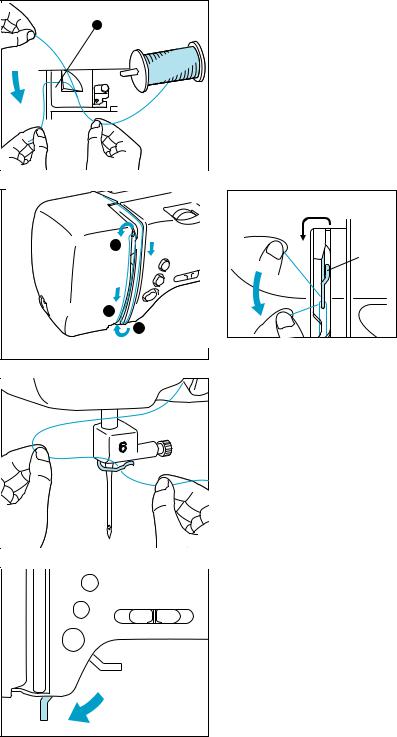
1 |
▼ |
4.Guide the thread as illustrated by the numbers and arrow marks on the machine. Threading is easy if you hold the thread gently with your right hand while guiding the and of the thread with your left hand.
1 Run the thread all the way through the thread guides.
1 Thread take-up lever
Threading the take-up lever
4
1
▼
*Threading is easy if you hold the thread gently with your left hand while guiding the end of the thread with your right hand.
5. Lower the presser foot.
21

6. Run thread through the guide above the needle.
1 |
HOW TO USE THE AUTOMATIC NEEDLE THREADER |
|
CAUTION
-Be careful not to turn the machine on while using the
automatic needle threader.
-Use the automatic needle threader with size #11-16
sewing machine needles. Use the quick reference chart (p. 35) to make sure you're using the right needle.
|
1 Lower the needle threader lever all the way down using |
2 |
your left index finger. (Pass thread to the right. ) |
1 Guide (Large hook)
2 Push the automatic needle threader lever to the back, pass the third hook through the eye of the needle, then scoop
3
the thread up from below and through the third hook.
2 Needle threader lever
3 Thread hook
3 While gently holding the thread, pull the needle threader lever toward you.
4 Simultaneously release both thread and automatic needle threader lever. The threading hook will pass the thread through the eye of the needle.
5 Pull the thread towards the rear to finish the upper threading.
CAUTION
Be careful not to force the thread and bend or damage the needle.
7. Pass the thread underneath the presser foot and pull it out from the rear of the machine by about 5 cm (13/64”).
22
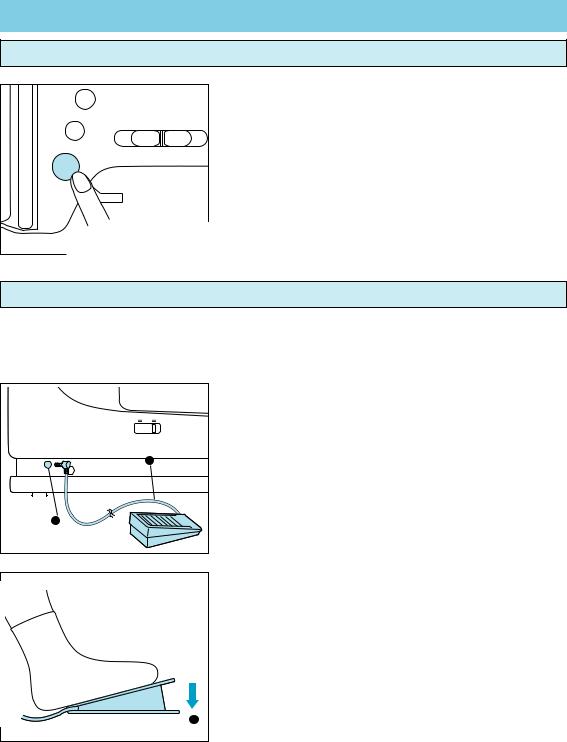
STARTING AND STOPPING SEWING
“START/STOP” button
1.Place the fabric under the presser foot, lower the presser foot, and then press the “START/STOP” button. The sewing machine starts sewing.
*Adjust speed by sliding the speed control lever.
* Sewing continues at low speed while the button is pressed.
2. And then press it once more to stop the machine.
Foot controller
CAUTION
Do not allow fabric pieces and dust to collect in the foot controller. Doing so could cause a fire or an electric shock.
1. Turn the power off and plug the foot controller plug into the jack on the back of the machine.
* The foot controller can not be used during machine embroidery.
1
1 Foot controller
2 Foot controller jack
2
2.When the foot controller is depressed lightly, the machine will run at a low speed.
*The speed selected by the speed control lever on the body of the machine will be the maximum speed of the foot controller.
1 Faster
3. When pressure on the foot controller is released, the machine
1will stop.
*When the foot controller is being used, the “START/STOP” button has no effect on the sewing.
Note (For U.S.A. only)
Foot controller: Mxodel N5V
This foot controller can be used for sewing machine model PE- 300S/PE-400D.
23
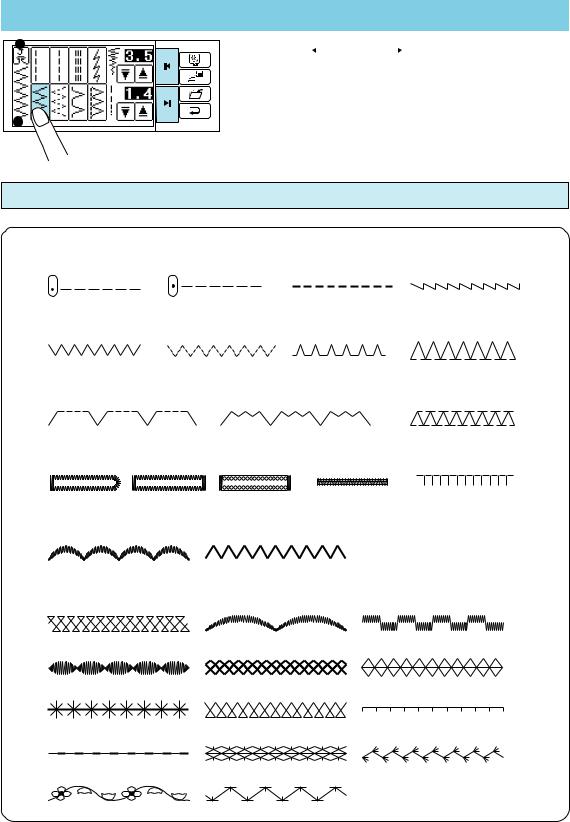
STITCH SELECTION (UTILITY STITCHES)
1 |
2 |
Press the “ |
|
|
” key and “ |
|
|
|
” keys to get to the screen of |
|
|
|
|
|
|||
|
|
|
|||||
|
|
|
|
|
|
|
|
the stitch y ou wish to use . Then press the desired stitch to
select it.
1Presser foot symbol
*Replace with the presser foot with the letter indicated. 2 Pattern being selected
Stitches
● Straight (Left) |
● Straight (Middle) |
● Triple stitch |
● Stretch stitch |
● Zigzag |
● Elastic zigzag |
● Overcasting |
● Overcasting |
● Blind hem stitch |
● Blind hem stitch |
● Patchwork stitch |
|
● Buttonhole |
● Bar tack |
● Applique |
● Scallop |
● Triple zigzag |
|
● Decorative stitch |
|
|
24
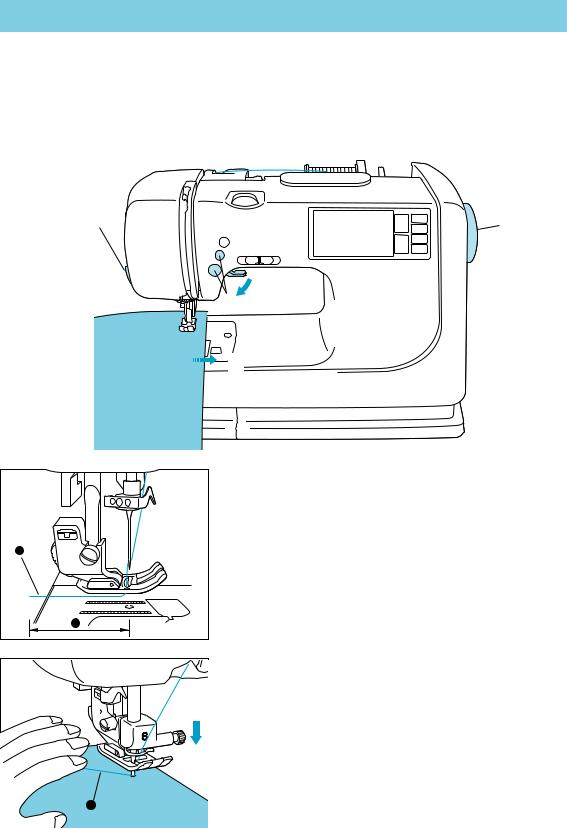
TRIAL SEWING
CAUTION
–Be aware of the needle at all times while sewing, and keep your hands away from all moving parts such as the needle, balance wheel and thread take-up lever, otherwise injury may result.
–Do not pull or push the fabric too hard while sewing, otherwise injury may result.
–Never use bent needles. Such needles can easily break, which could result in injury.
6 |
3 |
|
4
5
2
 1
1
1. |
When the machine is turned on, the straight stitch (left) is al- |
|
|
ways selected. |
|
2. |
Pass the thread underneath the presser foot and pull it out |
|
|
from the rear of the machine by about 5 cm. |
|
1 |
1 |
Upper thread |
|
2 |
5 cm (13/64”) |
|
* |
Sewing can begin without pulling out the bobbin thread. |
|
* |
Use the J presser foot. |
2 |
|
|
3. |
While pressing down on the thread and the fabric with your |
|
|
left hand, turn the balance wheel with your right hand to lower |
|
|
the needle to the sewing start position. |
|
|
1 |
Thread |
1
25
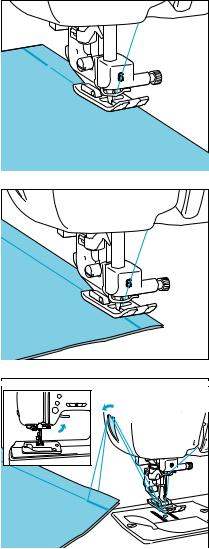
4.Lower the presser foot. Press the “REVERSE STITCH” button to sew a reverse stitch, and then press the “START/STOP” button. The machine will start sewing at slow speed.
*Sew reverse stitches at the beginning and end of stitches to reinforce them.
5.When sewing is completed, press the “REVERSE STITCH” button to sew a reverse stitch.
*Reverse stitches are sewn while the “REVERSE STITCH” button is pressed.
*Sewing in reverse is carried out at a slow sewing speed.
*Sews in place when sewing any stitch other than a straight stitch or zigzag stitch.
6. Raise the presser foot, remove the fabric and cut the thread.
26
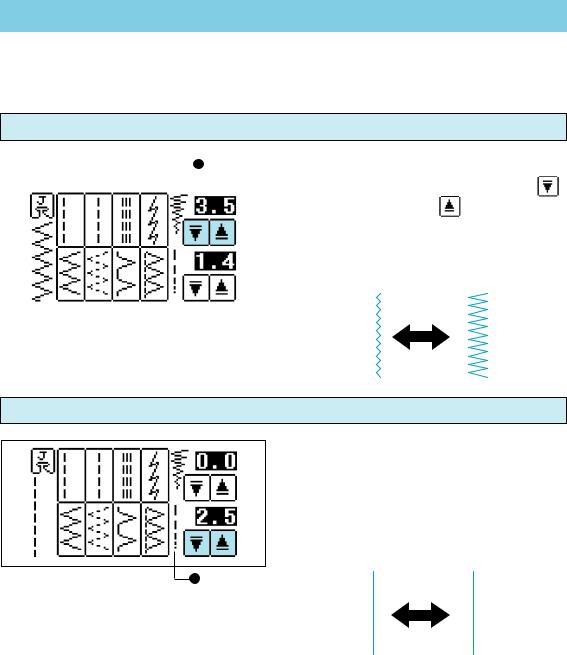
STITCH WIDTH AND STITCH LENGTH
Your machine will automatically set stitch length and width when a stitch is selected. See the following instructions if you wish to further adjust stitch length or width.
Adjusting the stitch width
|
|
1 |
The two arrow buttons next to the stitch width mark |
||
|
|||||
|
|
|
(top pair of arrows) adjust stitch width. Press “ |
” |
|
|
|
|
|||
|
|
|
key for narrower widths and “ |
” key for wider stitch |
|
|
|
|
widths. |
|
|
|
|
|
1 Stitch Width |
|
|
|
|
|
|
|
|
Adjusting the stitch length
The two arrow buttons next to the stitch length mark
(bottom pair of arrows) adjust stitch length. Press “
 ” key for shorter lengths and “
” key for shorter lengths and “  ” key for longer stitch lengths.
” key for longer stitch lengths.
1 Stitch Length
1
27
